Page 214 of 660
2144-2. Driving procedures
AVENSIS_OM_OM20C79E_(EE)
Multidrive
Stop the vehicle.
Set the parking brake (P. 230), and shift the shift lever to P.
Press the engine switch.
Release the brake pedal and check that the indicator on the engine
switch is off.
Manual transmission
Stop the vehicle.
Shift the shift lever to N.
Set the parking brake. (P. 230)
Press the engine switch.
Release the brake pedal and check that the indicator on the engine
switch is off.
Stopping the engine
1
2
3
4
1
2
3
4
5
Page 215 of 660
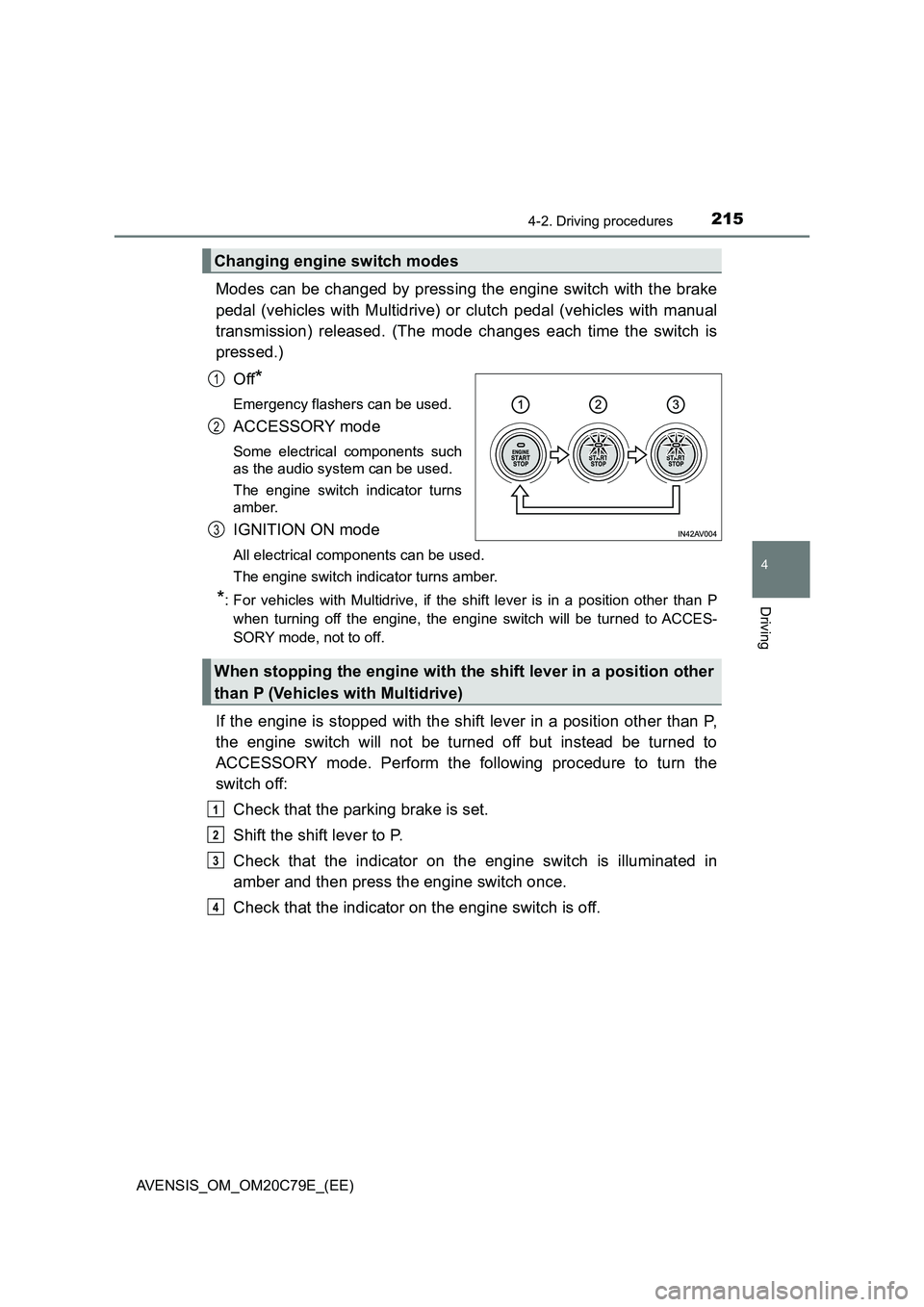
2154-2. Driving procedures
4
Driving
AVENSIS_OM_OM20C79E_(EE)
Modes can be changed by pressing the engine switch with the brake
pedal (vehicles with Multidrive) or clutch pedal (vehicles with manual
transmission) released. (The mode changes each time the switch is
pressed.)
Off
*
Emergency flashers can be used.
ACCESSORY mode
Some electrical components such
as the audio system can be used.
The engine switch indicator turns
amber.
IGNITION ON mode
All electrical components can be used.
The engine switch indicator turns amber.
*: For vehicles with Multidrive, if the shift lever is in a position other than P
when turning off the engine, the engine switch will be turned to ACCES-
SORY mode, not to off.
If the engine is stopped with the shift lever in a position other than P,
the engine switch will not be turned off but instead be turned to
ACCESSORY mode. Perform the following procedure to turn the
switch off:
Check that the parking brake is set.
Shift the shift lever to P.
Check that the indicator on the engine switch is illuminated in
amber and then press the engine switch once.
Check that the indicator on the engine switch is off.
Changing engine switch modes
1
2
3
When stopping the engine with the shift lever in a position other
than P (Vehicles with Multidrive)
1
2
3
4
Page 216 of 660
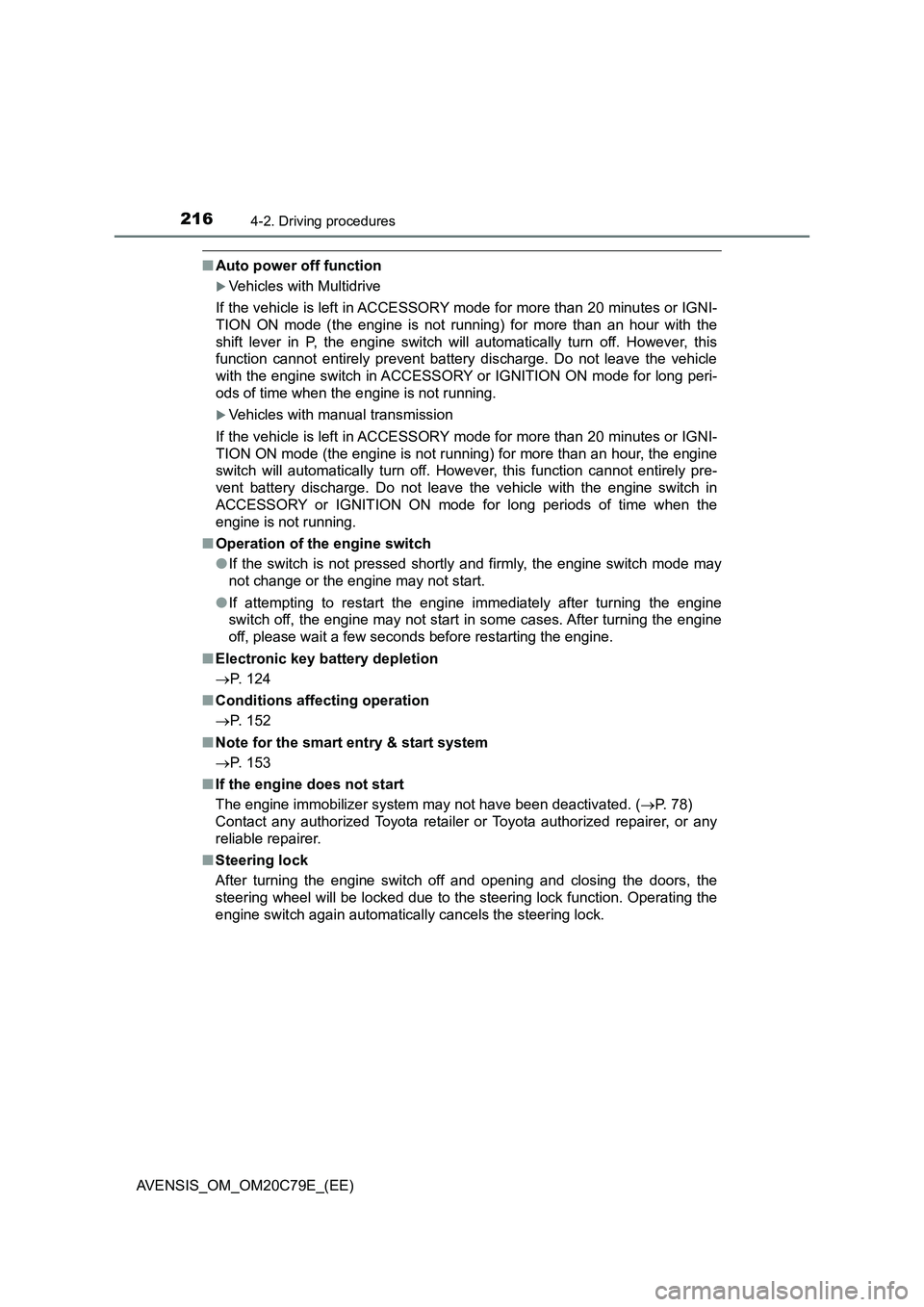
2164-2. Driving procedures
AVENSIS_OM_OM20C79E_(EE)
■Auto power off function
Vehicles with Multidrive
If the vehicle is left in ACCESSORY mode for more than 20 minutes or IGNI-
TION ON mode (the engine is not running) for more than an hour with the
shift lever in P, the engine switch will automatically turn off. However, this
function cannot entirely prevent battery discharge. Do not leave the vehicle
with the engine switch in ACCESSORY or IGNITION ON mode for long peri-
ods of time when the engine is not running.
Vehicles with manual transmission
If the vehicle is left in ACCESSORY mode for more than 20 minutes or IGNI-
TION ON mode (the engine is not running) for more than an hour, the engine
switch will automatically turn off. However, this function cannot entirely pre-
vent battery discharge. Do not leave the vehicle with the engine switch in
ACCESSORY or IGNITION ON mode for long periods of time when the
engine is not running.
■Operation of the engine switch
●If the switch is not pressed shortly and firmly, the engine switch mode may
not change or the engine may not start.
●If attempting to restart the engine immediately after turning the engine
switch off, the engine may not start in some cases. After turning the engine
off, please wait a few seconds before restarting the engine.
■Electronic key battery depletion
P. 124
■Conditions affecting operation
P. 152
■Note for the smart entry & start system
P. 153
■If the engine does not start
The engine immobilizer system may not have been deactivated. (P. 78)
Contact any authorized Toyota retailer or Toyota authorized repairer, or any
reliable repairer.
■Steering lock
After turning the engine switch off and opening and closing the doors, the
steering wheel will be locked due to the steering lock function. Operating the
engine switch again automatically cancels the steering lock.
Page 226 of 660
2264-2. Driving procedures
AVENSIS_OM_OM20C79E_(EE)
Manual transmission
Fully depress the clutch pedal
before operating the shift lever,
and then release it slowly.
Shift the shift lever to the R posi-
tion while lifting up the ring sec-
tion.
The Gear Shift Indicator display is a guide to help the driver achieve
improved fuel economy and reduced exhaust emissions within limits
of engine performance.
Upshifting
Downshifting
: If equipped
Shifting the shift lever
Shifting the shift lever to R
Gear Shift Indicator
1
2
Page 230 of 660
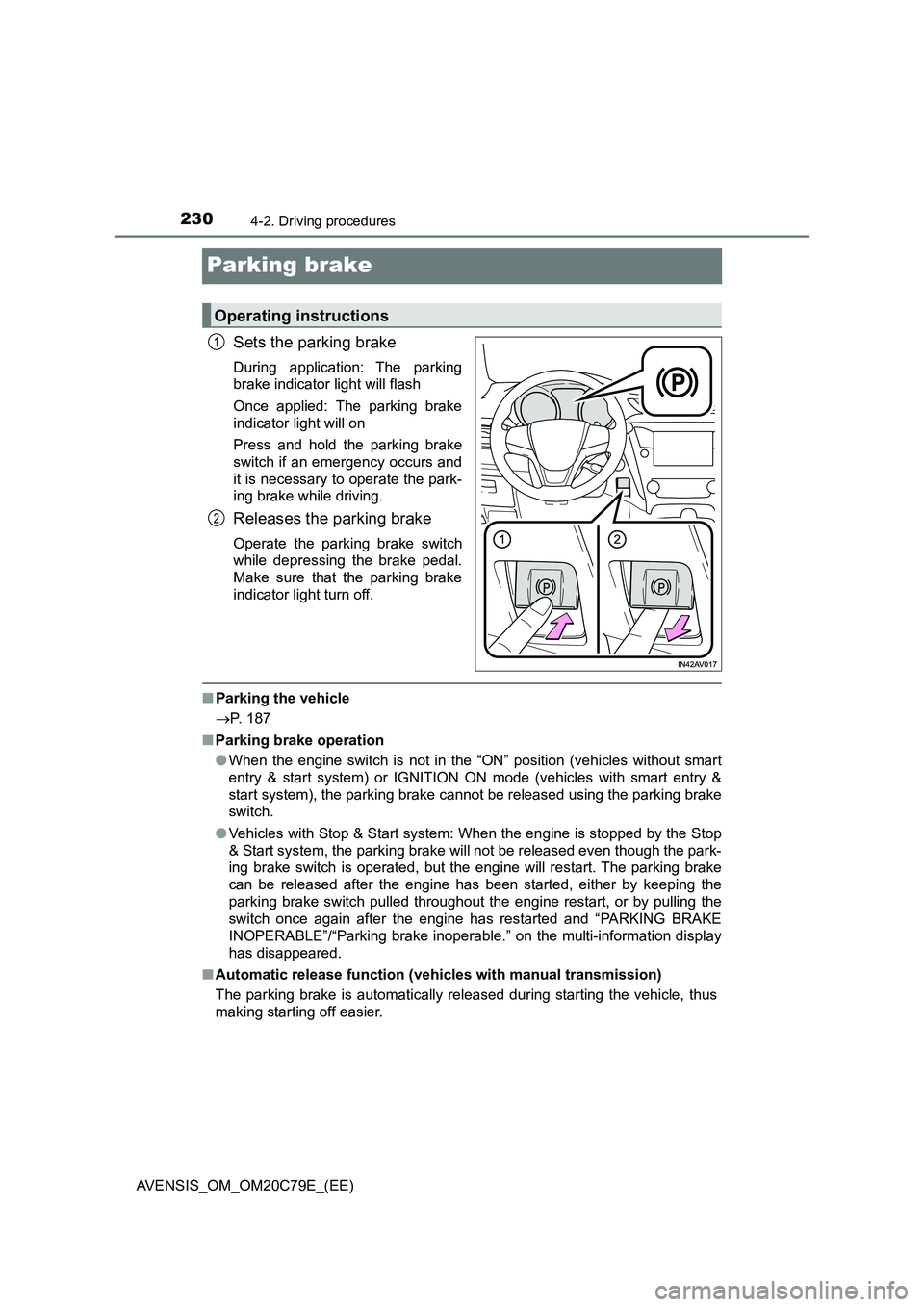
2304-2. Driving procedures
AVENSIS_OM_OM20C79E_(EE)
Parking brake
Sets the parking brake
During application: The parking
brake indicator light will flash
Once applied: The parking brake
indicator light will on
Press and hold the parking brake
switch if an emergency occurs and
it is necessary to operate the park-
ing brake while driving.
Releases the parking brake
Operate the parking brake switch
while depressing the brake pedal.
Make sure that the parking brake
indicator light turn off.
■Parking the vehicle
P. 187
■Parking brake operation
●When the engine switch is not in the “ON” position (vehicles without smart
entry & start system) or IGNITION ON mode (vehicles with smart entry &
start system), the parking brake cannot be released using the parking brake
switch.
●Vehicles with Stop & Start system: When the engine is stopped by the Stop
& Start system, the parking brake will not be released even though the park-
ing brake switch is operated, but the engine will restart. The parking brake
can be released after the engine has been started, either by keeping the
parking brake switch pulled throughout the engine restart, or by pulling the
switch once again after the engine has restarted and “PARKING BRAKE
INOPERABLE”/“Parking brake inoperable.” on the multi-information display
has disappeared.
■Automatic release function (vehicles with manual transmission)
The parking brake is automatically released during starting the vehicle, thus
making starting off easier.
Operating instructions
1
2
Page 231 of 660
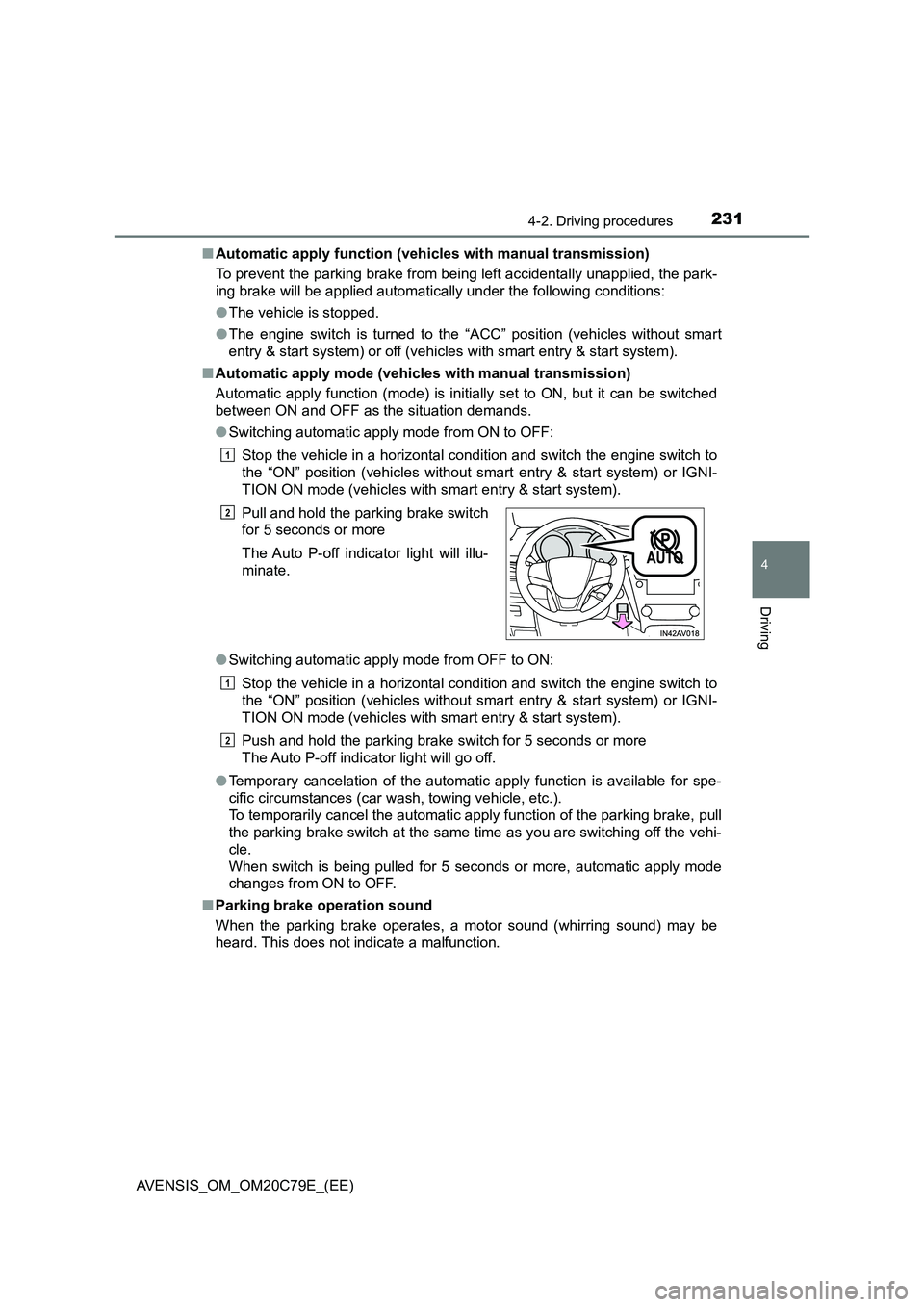
2314-2. Driving procedures
4
Driving
AVENSIS_OM_OM20C79E_(EE)■Automatic apply function (vehicles with manual transmission)
To prevent the parking brake from being left accidentally unapplied, the park-
ing brake will be applied automatically under the following conditions:
●The vehicle is stopped.
●The engine switch is turned to the “ACC” position (vehicles without smart
entry & start system) or off (vehicles with smart entry & start system).
■Automatic apply mode (vehicles with manual transmission)
Automatic apply function (mode) is initially set to ON, but it can be switched
between ON and OFF as the situation demands.
●Switching automatic apply mode from ON to OFF:
Stop the vehicle in a horizontal condition and switch the engine switch to
the “ON” position (vehicles without smart entry & start system) or IGNI-
TION ON mode (vehicles with smart entry & start system).
●Switching automatic apply mode from OFF to ON:
Stop the vehicle in a horizontal condition and switch the engine switch to
the “ON” position (vehicles without smart entry & start system) or IGNI-
TION ON mode (vehicles with smart entry & start system).
Push and hold the parking brake switch for 5 seconds or more
The Auto P-off indicator light will go off.
●Temporary cancelation of the automatic apply function is available for spe-
cific circumstances (car wash, towing vehicle, etc.).
To temporarily cancel the automatic apply function of the parking brake, pull
the parking brake switch at the same time as you are switching off the vehi-
cle.
When switch is being pulled for 5 seconds or more, automatic apply mode
changes from ON to OFF.
■Parking brake operation sound
When the parking brake operates, a motor sound (whirring sound) may be
heard. This does not indicate a malfunction.Pull and hold the parking brake switch
for 5 seconds or more
The Auto P-off indicator light will illu-
minate.
1
2
1
2
Page 290 of 660
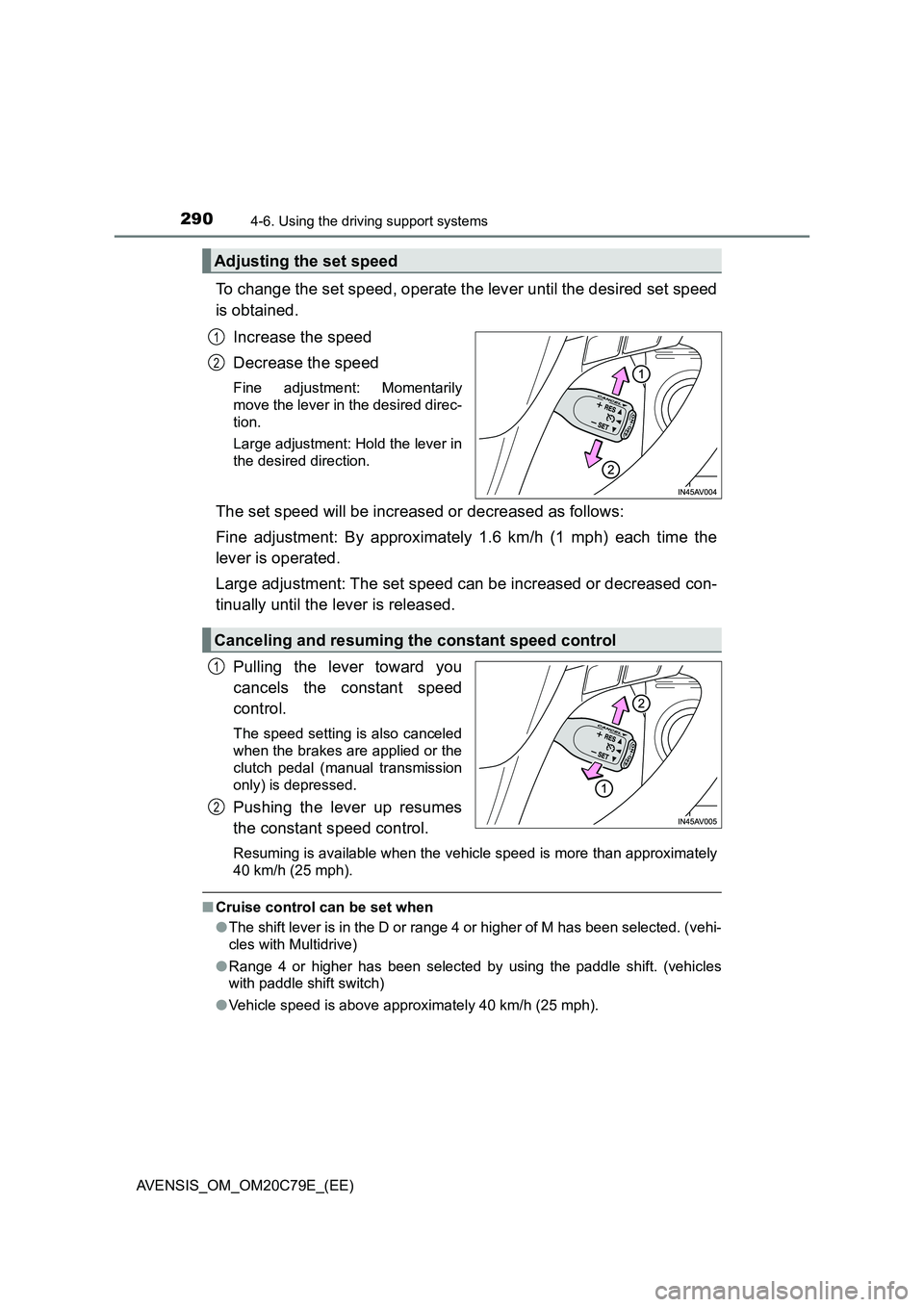
2904-6. Using the driving support systems
AVENSIS_OM_OM20C79E_(EE)
To change the set speed, operate the lever until the desired set speed
is obtained.
Increase the speed
Decrease the speed
Fine adjustment: Momentarily
move the lever in the desired direc-
tion.
Large adjustment: Hold the lever in
the desired direction.
The set speed will be increased or decreased as follows:
Fine adjustment: By approximately 1.6 km/h (1 mph) each time the
lever is operated.
Large adjustment: The set speed can be increased or decreased con-
tinually until the lever is released.
Pulling the lever toward you
cancels the constant speed
control.
The speed setting is also canceled
when the brakes are applied or the
clutch pedal (manual transmission
only) is depressed.
Pushing the lever up resumes
the constant speed control.
Resuming is available when the vehicle speed is more than approximately
40 km/h (25 mph).
■Cruise control can be set when
●The shift lever is in the D or range 4 or higher of M has been selected. (vehi-
cles with Multidrive)
●Range 4 or higher has been selected by using the paddle shift. (vehicles
with paddle shift switch)
●Vehicle speed is above approximately 40 km/h (25 mph).
Adjusting the set speed
1
2
Canceling and resuming the constant speed control
1
2
Page 309 of 660
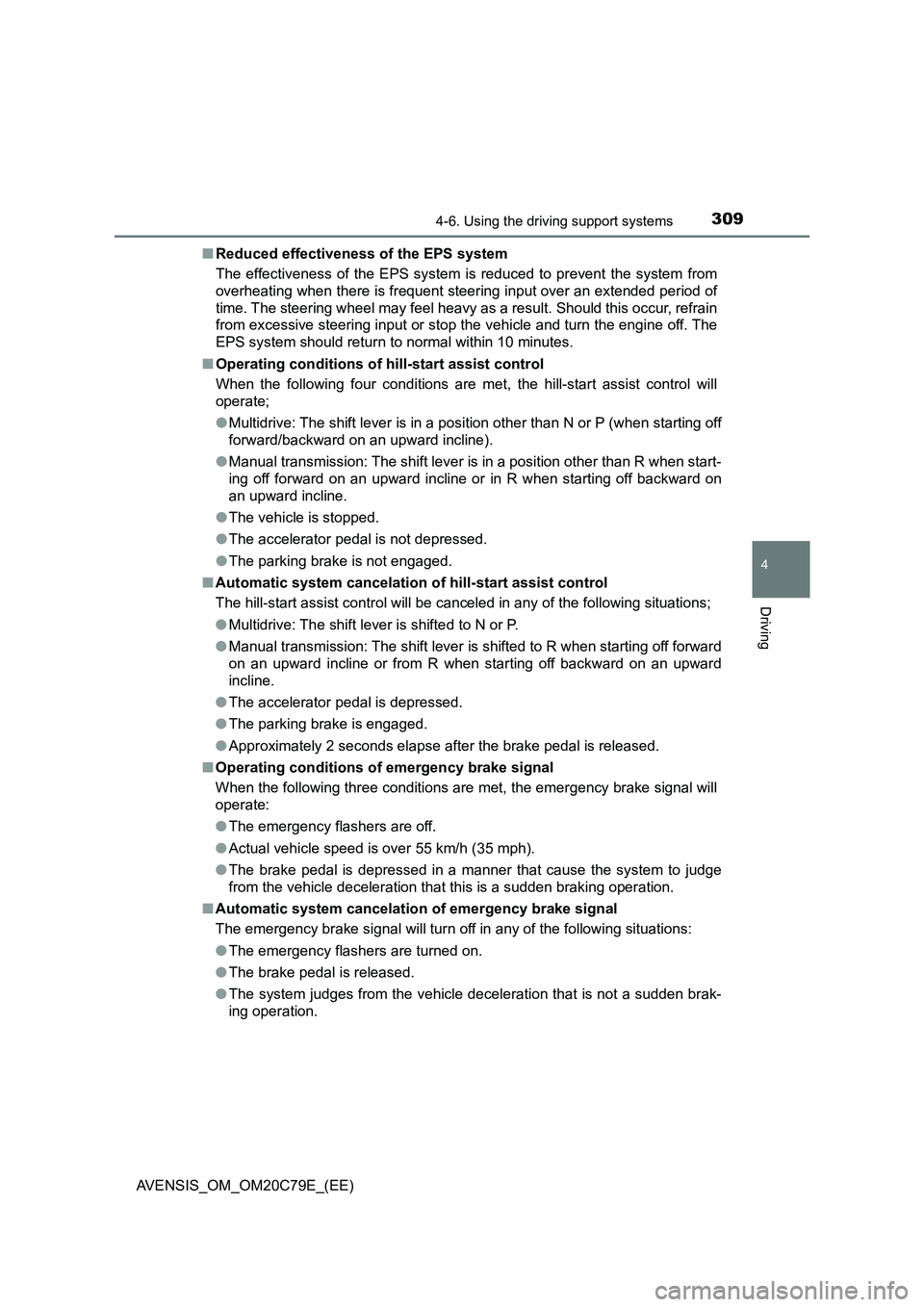
3094-6. Using the driving support systems
4
Driving
AVENSIS_OM_OM20C79E_(EE)■Reduced effectiveness of the EPS system
The effectiveness of the EPS system is reduced to prevent the system from
overheating when there is frequent steering input over an extended period of
time. The steering wheel may feel heavy as a result. Should this occur, refrain
from excessive steering input or stop the vehicle and turn the engine off. The
EPS system should return to normal within 10 minutes.
■Operating conditions of hill-start assist control
When the following four conditions are met, the hill-start assist control will
operate;
●Multidrive: The shift lever is in a position other than N or P (when starting off
forward/backward on an upward incline).
●Manual transmission: The shift lever is in a position other than R when start-
ing off forward on an upward incline or in R when starting off backward on
an upward incline.
●The vehicle is stopped.
●The accelerator pedal is not depressed.
●The parking brake is not engaged.
■Automatic system cancelation of hill-start assist control
The hill-start assist control will be canceled in any of the following situations;
●Multidrive: The shift lever is shifted to N or P.
●Manual transmission: The shift lever is shifted to R when starting off forward
on an upward incline or from R when starting off backward on an upward
incline.
●The accelerator pedal is depressed.
●The parking brake is engaged.
●Approximately 2 seconds elapse after the brake pedal is released.
■Operating conditions of emergency brake signal
When the following three conditions are met, the emergency brake signal will
operate:
●The emergency flashers are off.
●Actual vehicle speed is over 55 km/h (35 mph).
●The brake pedal is depressed in a manner that cause the system to judge
from the vehicle deceleration that this is a sudden braking operation.
■Automatic system cancelation of emergency brake signal
The emergency brake signal will turn off in any of the following situations:
●The emergency flashers are turned on.
●The brake pedal is released.
●The system judges from the vehicle deceleration that is not a sudden brak-
ing operation.